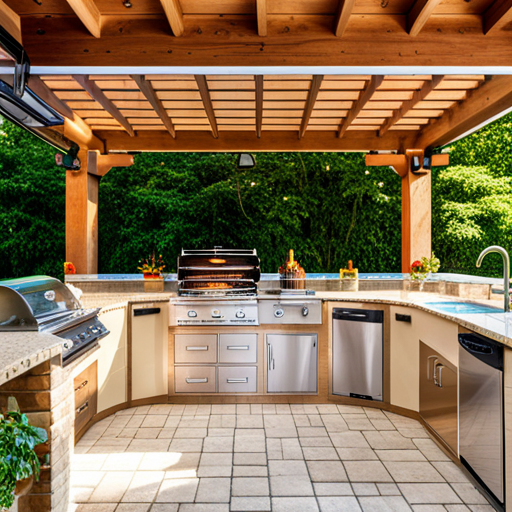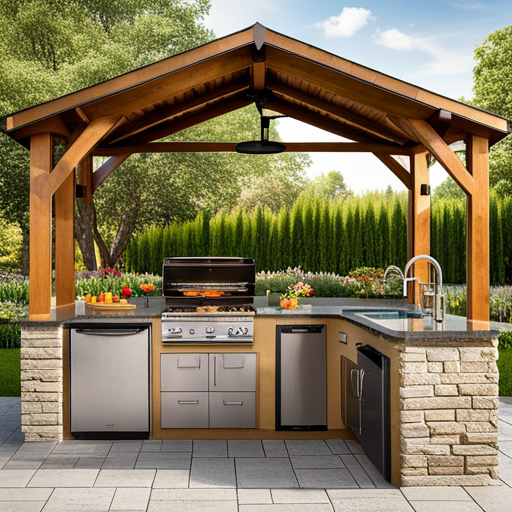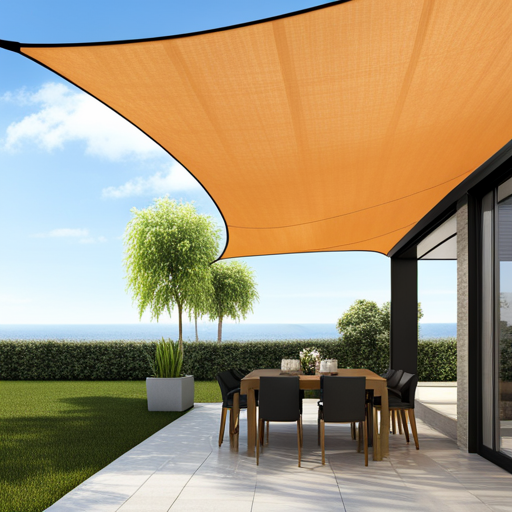Last Updated on June 19, 2024 by John Coleman
There are many factors to consider when buying the best outdoor wine fridge for your outdoor area. Here are the most important things to consider:
- Capacity and Size
- Type
- Durability and Weather Resistance
- Temperature Control and Zones
- Noise Level
- Cooling Technology
- Energy Efficiency
- Design and Aesthetics
- Maintenance and Care
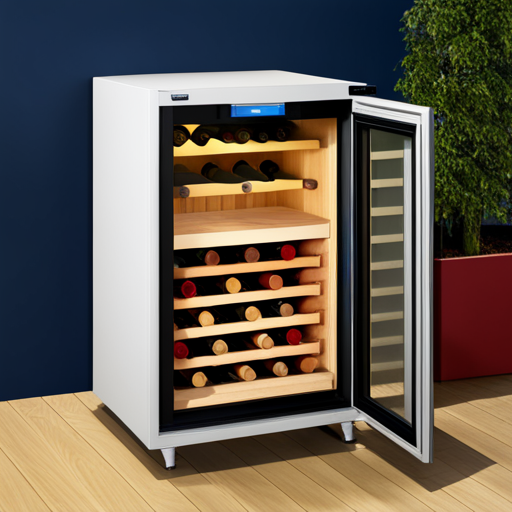
There is nothing more tranquil than pouring a glass of your favorite wine and heading out to your favorite outdoor space to unwind. As you indulge in the last sip of your exquisite Bordeaux or a refreshing Rosé on a warm evening, the necessity for optimal and convenient wine storage becomes abundantly clear. In this comprehensive guide, we’ll explore the essential considerations to ensure your relaxation or social atmosphere is coupled with perfectly chilled and preserved wine.
What is an Outdoor Wine Fridge?
A outdoor wine fridge, also known as an outdoor wine cooler, is a refrigeration unit specifically designed to store and age wines at their ideal temperature outdoors. Unlike regular refrigerators, which are typically set at temperatures below 40°F (4°C), wine fridges maintain a constant temperature between 45-65°F (7-18°C) – the perfect range for storing and aging wines. They also have humidity control, ensuring the cork doesn’t dry out and spoil the wine. In addition to humidity control, it consists of tilted wooden shelves that keep the wine against the cork to keep air out and prevent oxidization that will cause the wine to spoil. These wooden shelves will also naturally absorb a certain degree of vibration which will make the fridge quieter. It is also significant to note that a “wine” cooler is different from a “beverage” cooler in that it is specifically designed to maintain temperatures for wine.
What is the Difference Between a Wine Fridge and a Wine Cooler?
Many people use the terms “wine fridge” and “wine cooler” interchangeably, but there is a subtle difference between the two. A wine fridge is typically a larger unit that can store a significant number of bottles, while a wine cooler is smaller and more compact, often used for countertop or under-counter storage. Additionally, wine fridges may have multiple temperature zones, allowing you to store different types of wines at their ideal temperatures, while wine coolers typically only have one zone.
Why You Need an Outdoor Wine Fridge
If you’re serious about wine, having an outdoor wine fridge is a must. Here’s why:
- Perfect Temperature: Some wines improve with age, and a wine fridge is critical in this process, even outdoors. As mentioned earlier, regular refrigerators are too cold for wines while room temperature is too warm.
- Protection from Sunlight: Many outdoor wine fridges are equipped with a UV-resistant dual pane glass door. This is because sunlight can cause wines to age prematurely and develop off-flavors.
- Convenient Access: When entertaining guests outdoors, having a dedicated wine fridge eliminates the need to go back and forth inside your house to retrieve bottles. No more trips to the kitchen when you or your guests need a refill.
- Preservation of Wine Quality: Fine wine deserves careful treatment, and the right wine fridge will protect it from temperature fluctuations and humidity.
- Enhances Outdoor Living and Entertaining Experience: Elevate the sophistication and convenience of your outdoor gatherings.
Factors to Consider When Choosing an Outdoor Wine Fridge
Capacity and Size
Contemplate how many bottles you wish to store and the available space. A fridge that is too small may limit your collection, while one that is too large might be inefficient and take up precious space. Wine fridges are usually divided up into categories according to how many bottles they can hold. A wine fridge generally will fall into one of these basic capacity groups:
Small = <20 bottles
Medium = 20-50 bottles
Large = >50 bottles.
The size you choose will vary depending on the degree of wine connoisseur you are. Estimate how many bottles of wine you have on hand at any given moment and that will likely help you choose the capacity that will fit your needs perfectly.
Types of Wine Fridges
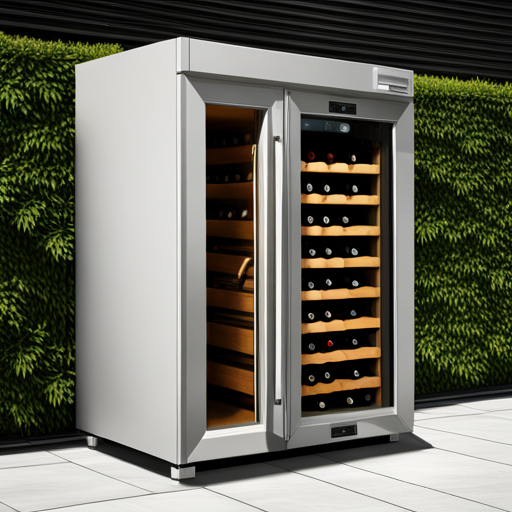
There are several different types of wine fridges to explore that could fit your needs. As you read about these types, think about where you plan to locate your wine fridge, how much space is available, and what type of aesthetic are you hoping to accomplish. The three most common types for outdoor area use are:
Built-In – These models are designed to fit into your outdoor kitchen or bar setup. They typically have a front vent and stainless steel casing that blends seamlessly with the rest of your outdoor appliances.
Freestanding – These models can be placed anywhere outdoors, as long as there is an electrical outlet nearby. They often come in different designs and finishes to complement your outdoor decor.
Reversible Hinge Doors – Some wine fridges come with reversible hinge doors, which allow you to open them from either the left or right side. This can be especially convenient if your space is limited and you need flexibility with placement. This also helps if your wine collection grows and you want to add another wine fridge next to your existing one. You can simply change one hinge to allow the door to open up to the left and then adjust the other so that it opens to the right.
Temperature Control and Zones
Wine fridges are designed to keep your wine at a specific temperature range, typically between 45-65 degrees Fahrenheit. That is why it is important to consider whether you need a single-zone or a dual-zone fridge. A dual-zone wine fridge will allow you to simultaneously store different types of wines at their optimal temperature for best preservation. Having a dual-zone wine fridge allows you to keep both different types of wine at their optimal temperatures without having to constantly adjust the overall temperature.
Additional Features
Aside from temperature control and aesthetics, wine fridges often come with additional features that make them more user-friendly and efficient. Some models have adjustable shelves to accommodate larger bottles or can holders to keep cans of beer or soda chilled. Others have LED lighting, touchscreen displays, and alarms that notify you when the temperature exceeds your desired range. It’s important to consider these extra features when choosing a wine fridge as they can greatly enhance your wine storage experience.
Energy Efficiency
Outdoor appliances generally consume more energy due to exposure to the elements. However, many wine fridge manufacturers have taken this into account and have created energy-efficient models specifically designed for outdoor use. Look for models that are Energy Star certified or have high energy efficiency ratings to save on your utility bill and reduce your carbon footprint.
Cooling Technology
Thermoelectric or compressor? Each technology has its upsides and downsides in terms of energy consumption, temperature stability, and environmental impact. Let’s break down each one to get a better understanding.
Thermoelectric – This type of cooling technology uses a thermocouple to transfer heat from one side of the fridge to the other, creating a cool environment for your wine. It’s energy-efficient and operates quietly, making it a great choice for outdoor areas that require minimal noise disturbance. However, thermoelectric fridges are not ideal for warm climates as their cooling capabilities decrease when ambient temperatures rise above 80°F.
Compressor – This type of cooling technology is similar to the one used in full-size refrigerators. It uses a compressor and coolant gas to keep your wine at the desired temperature. Compressor fridges are more powerful and can handle warmer temperatures, making them suitable for outdoor use. However, they tend to be less energy-efficient and noisier compared to thermoelectric fridges.
Durability and Weather Resistance
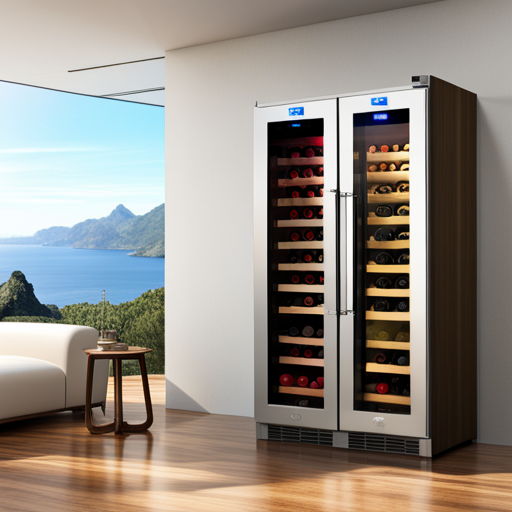
An outdoor wine fridge needs to withstand the elements. For outdoor use, it should be made of materials that are resistant to rust, corrosion, and UV rays. Stainless steel is a popular choice as it can withstand harsh weather conditions and maintain its sleek appearance. Look for models with an anti-UV coating on the exterior to prevent discoloration from sun exposure.
Additionally, consider the insulation of the fridge. The thicker the insulation, the better it will retain cold air and maintain a consistent temperature, even in hot weather. This is especially important for areas with extreme temperatures or where the fridge will be exposed to direct sunlight.
Noise Level
Silent operation might be important if your outdoor space is a haven of tranquility. Check the decibel level to ensure the fridge’s hum doesn’t disrupt your peace. A good decibel (dB) range will fall between 30dB and 45dB. Remember, the lower the dB, the quieter the fridge will be.
Design and Aesthetics
Your outdoor wine fridge should complement your outdoor decor. Whether built-in or freestanding, the right look can enhance the overall ambiance. Consider the size, color, and finish of the fridge. Stainless steel is a classic and versatile option, but there are also other options such as black or wood paneling to match your outdoor furniture.
If you purchase through links on this site, we may earn a small commission. See our affiliate disclosure.
Considering Different Brands and Models
There are high-end brands with a familiar name that you will likely consider but don’t forget to look at cost-effective models too. No matter which model you choose, if you plan to put the wine fridge outside, you need to make sure the materials can hold up to the elements of the outdoors. This would include materials such as stainless steel and double-pane UV-resistant glass.
Maintenance and Care Tips
Even the best outdoor wine fridge requires regular maintenance. Keep it clean, ensure the seals are tight, and occasionally check the temperature settings to avoid unwelcome surprises. Here are some additional tips to help keep your outdoor wine fridge in top condition:
- Regularly clean the interior and exterior of the fridge with a mild detergent solution, avoiding harsh chemicals.
- Check the door seals regularly to ensure they are tight and not letting precious cold air out.
- Keep an eye on the temperature settings, especially during hot summer months or extreme weather conditions. Adjust accordingly to maintain ideal storage conditions for your wine.
- Avoid placing the fridge in direct sunlight or areas with high heat, as this can affect the internal temperature and cause damage to the wine.
- Consider investing in a cover for your outdoor wine fridge to protect it from the elements when not in use.
- If you live in an area with harsh winters, make sure to properly winterize your outdoor wine fridge to prevent damage from freezing temperatures. This may include storing the fridge in a protected area.
- Regularly check and clean the condenser coils for dust or debris buildup, as this can affect the efficiency of the fridge.
- For built-in models, make sure there is adequate ventilation space around the fridge to ensure proper air circulation and prevent overheating.
- Consider investing in a temperature and humidity monitor to keep track of the conditions inside your outdoor wine fridge.
By following these maintenance tips, you can ensure that your outdoor wine fridge remains in top condition and continues to provide the perfect storage environment for your prized wine collection.
If you purchase through links on this site, we may earn a small commission. See our affiliate disclosure.

Conclusion
Taking proper care of your outdoor wine fridge is crucial to preserving your valuable wines in their prime condition. By proactively managing temperature settings, shielding the fridge from extreme weather and direct sunlight, and ensuring routine upkeep, you can extend the lifespan of this appliance. Consider investing in a temperature and humidity monitor to enhance your ability to maintain the perfect storage environment. Remember, outdoor wine fridges are not just significant investments for managing wine collections but also for enhancing your outdoor entertaining space. With diligent attention to these tips, your fridge will continue to be a reliable haven for your cherished vintages for years to come. Cheers!
Frequently Asked Questions
Q: Can I keep my outdoor wine fridge outside year-round?
A: Depending on your climate, you may be able to keep it outside year-round. However, if temperatures dip below freezing, it’s important to winterize your fridge to prevent damage.
Q: How often should I clean the condenser coils on my outdoor wine fridge?
A: You should clean the condenser coils every three to six months, or more often if you’re in a dusty area.
Q: How do I properly winterize my outdoor wine fridge?
A: Winterizing involves draining water lines, disconnecting power, and storing the fridge in a protected area if possible.
Q: Is a special cover necessary for protecting my outdoor wine fridge?
A: A cover is recommended to protect your fridge from rain, dust, and other outdoor elements when not in use.
Q: What is the ideal temperature and humidity level for storing wine?
A: The ideal temperature is around 55°F (13°C), with a humidity level of 60-70%.
Q: Can I install a built-in outdoor wine fridge myself?
A: It’s possible if you are handy and follow the manufacturer’s instructions carefully, but professional installation is recommended to ensure proper ventilation and function.
Q: How do I know if my wine fridge is set to the right temperature?
A: Using a temperature and humidity monitor will help you keep track of the internal conditions to ensure they are optimal for wine storage.
Q: What should I do if my outdoor wine fridge stops cooling properly?
A: Check the condenser coils for debris and the thermostat settings first. If it’s still not cooling, contact the manufacturer or a professional service technician.


